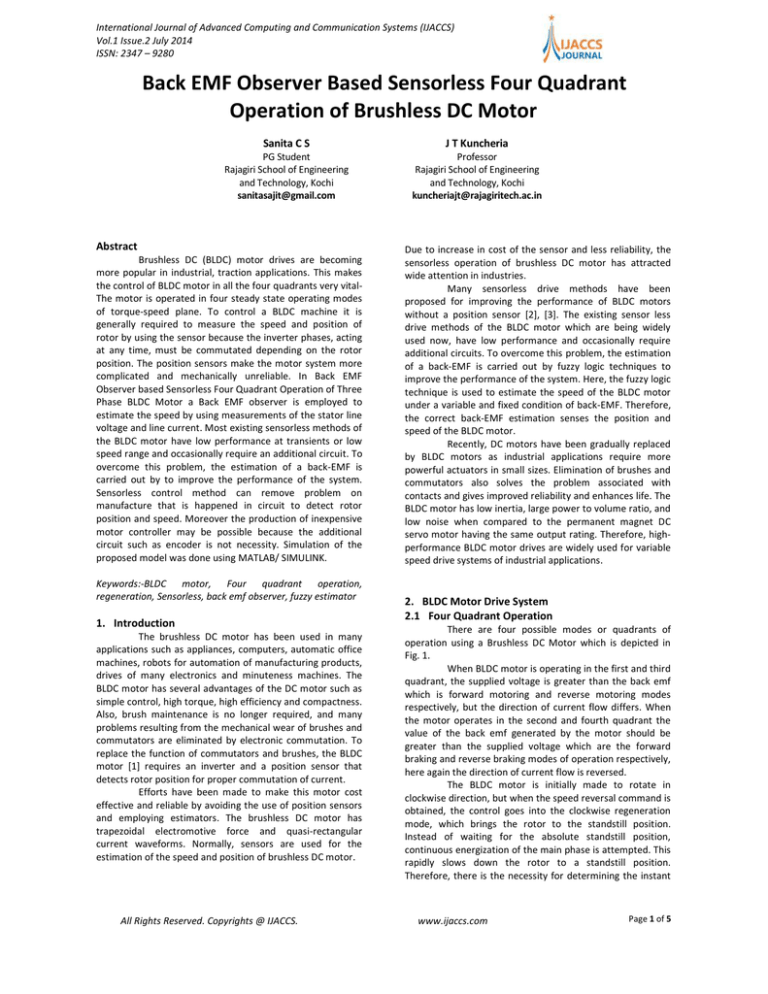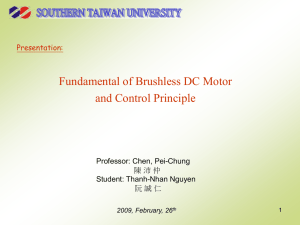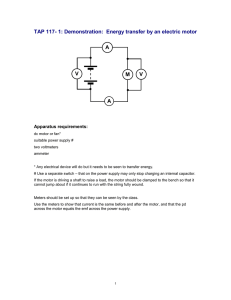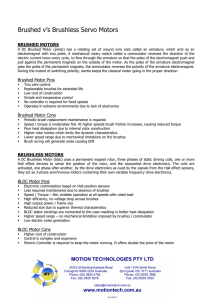
International Journal of Advanced Computing and Communication Systems (IJACCS)
Vol.1 Issue.2 July 2014
ISSN: 2347 – 9280
Back EMF Observer Based Sensorless Four Quadrant
Operation of Brushless DC Motor
Sanita C S
J T Kuncheria
PG Student
Rajagiri School of Engineering
and Technology, Kochi
sanitasajit@gmail.com
Professor
Rajagiri School of Engineering
and Technology, Kochi
kuncheriajt@rajagiritech.ac.in
Abstract
Brushless DC (BLDC) motor drives are becoming
more popular in industrial, traction applications. This makes
the control of BLDC motor in all the four quadrants very vitalThe motor is operated in four steady state operating modes
of torque-speed plane. To control a BLDC machine it is
generally required to measure the speed and position of
rotor by using the sensor because the inverter phases, acting
at any time, must be commutated depending on the rotor
position. The position sensors make the motor system more
complicated and mechanically unreliable. In Back EMF
Observer based Sensorless Four Quadrant Operation of Three
Phase BLDC Motor a Back EMF observer is employed to
estimate the speed by using measurements of the stator line
voltage and line current. Most existing sensorless methods of
the BLDC motor have low performance at transients or low
speed range and occasionally require an additional circuit. To
overcome this problem, the estimation of a back-EMF is
carried out by to improve the performance of the system.
Sensorless control method can remove problem on
manufacture that is happened in circuit to detect rotor
position and speed. Moreover the production of inexpensive
motor controller may be possible because the additional
circuit such as encoder is not necessity. Simulation of the
proposed model was done using MATLAB/ SIMULINK.
Keywords:-BLDC motor, Four quadrant operation,
regeneration, Sensorless, back emf observer, fuzzy estimator
1. Introduction
The brushless DC motor has been used in many
applications such as appliances, computers, automatic office
machines, robots for automation of manufacturing products,
drives of many electronics and minuteness machines. The
BLDC motor has several advantages of the DC motor such as
simple control, high torque, high efficiency and compactness.
Also, brush maintenance is no longer required, and many
problems resulting from the mechanical wear of brushes and
commutators are eliminated by electronic commutation. To
replace the function of commutators and brushes, the BLDC
motor [1] requires an inverter and a position sensor that
detects rotor position for proper commutation of current.
Efforts have been made to make this motor cost
effective and reliable by avoiding the use of position sensors
and employing estimators. The brushless DC motor has
trapezoidal electromotive force and quasi-rectangular
current waveforms. Normally, sensors are used for the
estimation of the speed and position of brushless DC motor.
All Rights Reserved. Copyrights @ IJACCS.
Due to increase in cost of the sensor and less reliability, the
sensorless operation of brushless DC motor has attracted
wide attention in industries.
Many sensorless drive methods have been
proposed for improving the performance of BLDC motors
without a position sensor [2], [3]. The existing sensor less
drive methods of the BLDC motor which are being widely
used now, have low performance and occasionally require
additional circuits. To overcome this problem, the estimation
of a back-EMF is carried out by fuzzy logic techniques to
improve the performance of the system. Here, the fuzzy logic
technique is used to estimate the speed of the BLDC motor
under a variable and fixed condition of back-EMF. Therefore,
the correct back-EMF estimation senses the position and
speed of the BLDC motor.
Recently, DC motors have been gradually replaced
by BLDC motors as industrial applications require more
powerful actuators in small sizes. Elimination of brushes and
commutators also solves the problem associated with
contacts and gives improved reliability and enhances life. The
BLDC motor has low inertia, large power to volume ratio, and
low noise when compared to the permanent magnet DC
servo motor having the same output rating. Therefore, highperformance BLDC motor drives are widely used for variable
speed drive systems of industrial applications.
2. BLDC Motor Drive System
2.1 Four Quadrant Operation
There are four possible modes or quadrants of
operation using a Brushless DC Motor which is depicted in
Fig. 1.
When BLDC motor is operating in the first and third
quadrant, the supplied voltage is greater than the back emf
which is forward motoring and reverse motoring modes
respectively, but the direction of current flow differs. When
the motor operates in the second and fourth quadrant the
value of the back emf generated by the motor should be
greater than the supplied voltage which are the forward
braking and reverse braking modes of operation respectively,
here again the direction of current flow is reversed.
The BLDC motor is initially made to rotate in
clockwise direction, but when the speed reversal command is
obtained, the control goes into the clockwise regeneration
mode, which brings the rotor to the standstill position.
Instead of waiting for the absolute standstill position,
continuous energization of the main phase is attempted. This
rapidly slows down the rotor to a standstill position.
Therefore, there is the necessity for determining the instant
www.ijaccs.com
Page 1 of 5
International Journal of Advanced Computing and Communication Systems (IJACCS)
Vol.1 Issue.2 July 2014
ISSN: 2347 – 9280
when the rotor of the machine is ideally positioned for
reversal.
approximator that can estimate voluntary non-linear function
is applied to the back-EMF disturbance model.
The structure of the proposed fuzzy back-EMF observer is
shown in Fig. 4.
Fig.3 Back Emf Observer
Fig.1 Four quadrant of operation
2.2 Proposed scheme
The overall structure of the proposed Sensorless
drive system is given in Fig. 2.
The fuzzy logic back EMF estimator has two stages: first is the
calculation and comparison of the currents, second is
estimation of the change in back EMF and the Back EMF. The
inputs of the fuzzy function are the line to line current error
of the BLDC motor and the differential value of the error.
Fig.2 Proposed scheme
2.3 Back EMF estimator
The proposed method is based on the fact that the
rotor position can be detected by using a trapezoidal backEMF of BLDC motors. Since a back-EMF of the BLDC motor is
not measured directly, it is estimated by the unknown input
observer. This unknown input observer is constructed by a
back-EMF regarded as an unknown input and state of the
BLDC motor drive system.
Since the neutral point of the BLDC motor is not
offered, it is difficult to construct the equation for one phase.
Therefore, the unknown input observer is considered by the
following line-to-line equation:
d
2R
1
1
V ab
e
I ab
I ab
dt
2L
2L
2 L ab
Iab and Vab can be measured, therefore they are “known”
state variables. On the other hand, since eab cannot be
measured, this term is considered as an “unknown” state.
The equation (7) can be rewritten in the following form:
dx
Ax Bu Ew
dt
y Cx
This disturbance model cannot exactly represent
the back-EMF of trapezoidal shape, so a fuzzy function
All Rights Reserved. Copyrights @ IJACCS.
Fig.4 Membership Function (a) Error (b) Change in Error (c) Output
The fuzzy function includes three stages:
fuzzification, inference mechanism and de-fuzzification. Zero:
Z, Positive Big: PB, Positive Medium: PM, Positive Small: PS,
Negative Big: NB, Negative Medium: NM, Negative Small: NS.
Fig. 4. The value of the fuzzy output is determined using a
rule base Table 1. The approximation law of the fuzzy
function approximator contains 49 rules.
Table.1 Fuzzy Rule
CE E
NB NM
NB
NM
NS
Z
PS
PM
PB
NB
NB
NB
NB
NM
NS
Z
www.ijaccs.com
NB
NB
NB
NM
NS
Z
PS
NS
NB
NB
NM
NS
Z
PS
PM
Z
NB
NM
NS
Z
PS
PM
PB
PS
NM
NS
Z
PS
PM
PB
PB
PM
NS
Z
PS
PM
PB
PB
PB
PB
Z
PS
PM
PB
PB
PB
PB
Page 2 of 5
International Journal of Advanced Computing and Communication Systems (IJACCS)
Vol.1 Issue.2 July 2014
ISSN: 2347 – 9280
2.4 Speed and Position Estimation
Relation between the back-EMF and speed in BLDC
motor is given by
E k e e
Where ke is back EMF constant
2.5 Speed Controller
The speed controller module adopts discrete sliding
mode control (SMC) algorithm. The inputs of the module are
ωr* and ωr. ωr * is the reference signal and ωr is the
feedback signal of the rotating speed. The output signal has
negative saturated limiting value and positive saturated
limiting value. The saturated limiting value is the maximum
current value.
2.6 The reference current generator
The reference current generating module has two
inputs. One is the output of the speed control module Is* and
the other is the angular displacement signal of the rotor
angle. The output of the module is the current of the threephase winding.
2.7 Hysteresis current controller
Hysteresis current control is a PWM technique,
very simple to implement and taking care directly for the
current control. The switching logic is realized by three
hysteresis controllers, one for each phase. The hysteresis
PWM current control, also known as bang-bang control, is
done in the three phases separately. Each controller
determines the switching-state of one inverter half-bridge in
such a way that the corresponding current is maintained
within a hysteresis band.
2.8 Voltage Source Inverter
The inverter supplies the input voltage for the
three phases of the BLDC motor. It comprises of two power
semiconductor devices on each phase leg. Appropriate pairs
of MOSFET’s (S1 to S6) are driven based on the switching
o
states. Three phases are commutated for every 60 .
3. Simulation Results
With Simulation of the drive model with back EMF
estimator is done in MATLAB/ SIMULINK. Runge-Kutta
numerical integration method is used to get the solution of
the equations. The transient and steady state responses of a
3 phase, 2.0 hp, 2 pole, 1500 rpm, 4 A PMBLDC motor are
shown in Figures. The specifications of the PMBLDC motor
are given in Table 2.
Table.2 Motor Parameters
No. of Poles
2
No. of Phases
3
Type of connection
Star
Rated Speed
1500 rpm
Resistance/Ph
1Ω
Back EMF Constant
0.41V-Sec/rad
Self & Mutual Inductance
0.0267H/phase
Moment of Inertia
0.005kg/m2
Fig.5
All Rights Reserved. Copyrights @ IJACCS.
www.ijaccs.com
Page 3 of 5
International Journal of Advanced Computing and Communication Systems (IJACCS)
Vol.1 Issue.2 July 2014
ISSN: 2347 – 9280
response of the drive with estimator under speed reversal.
The drive takes .34sec to reach the set speed of -1500rpm.
The response is smooth and no oscillation in the case of
present control scheme. This is due to robust and accurate
estimation of Back EMF by estimator.
In the motoring mode, the back-emf magnitude
increases until the steady state is reached and in braking
mode back-emf starts decreasing towards zero. In the
motoring mode, the corresponding back-emf and phase
current is in phase. In braking mode the back-EMF and phase
current are out of phase.
4. Conclusions
This paper proposed a back-EMF observer that
continuously estimates a back-EMF of trapezoidal shape. A
control scheme is proposed for BLDC motor to change the
direction from CW to CCW and the speed control is achieved
both for servo response and regulator response.
The significant advantages of the proposed work
are: reliability of the control algorithm, excellent speed
control, smooth transition between the quadrants and
efficient conservation of energy is achieved with and without
load conditions. The technical validity of the proposed
algorithm has been shown through simulation using the
MATLAB.
5. References
Fig.6
At initial conditions, the motor is operated in
(Quad-I) Forward motoring mode. Fig. 5 shows the rotor
speed, winding current, developed torque, back EMF and
rotor position of the PMBLDC drive from standstill to a speed
of 1500rpm. The EMF estimator estimates the back EMF of
the BLDC drive which exactly matches with the actual back
EMF.
When a speed reversal command is issued, the
motor undergoes braking operation in forward direction,
with speed tending to zero and starts rotating in reverse
direction as soon as the speed is zero. Fig. 6 shows the speed
All Rights Reserved. Copyrights @ IJACCS.
[1] Tavel, P. 2007 Modeling and Simulation Design. AK
Peters Ltd.
[2] T. J. E Miller, Brushless Permanent Magnet and
Reluctance Motor Drives, Clarendon Press, Oxford,
1989.
[3] S. Ogasawara and H. Akagi, "An Approach to position
sensorless drive for brushless DC motors," IEEE Trans.
Ind. Appl., vol. 27, no. 5, pp. 928-933, Sep./Oct. 1991.
[4] R. C. Becerra, T. M. Jahns, and M. Ehsani, "Fourquadrant sensorless brushless ECM drive," in Proc. IEEE
Appl. Power. Electron. Conf., APEC’91, pp. 202-209,
1991.
[5] P. Yedamale, Microchip Technology Inc., “Brushless DC
(BLDC) motor fundamentals,” 2003, AN885.
[6] B. Singh and S. Singh, “State of the art on permanent
magnet brushless DC motor drives,” J. Power Electron.,
vol. 9, no. 1, pp. 1–17, Jan. 2009.
[7] C. S. Joice and Dr. S. R. Paranjothi, “Simulation of closed
loop control of four quadrant operation in three phase
brushless DC motor using MATLAB/simulink,” in Proc.
ICPCES, 2010, pp. 259–263.
[8] L. H. Tsoukalas and R. E. Uhrig, Fuzzy and Neural
Approaches in Engineering, John Wiley & Sons, Inc.,
1997.
[9] C. C. Lee, "Fuzzy logic in control systems: fuzzy logic
controller-part I & Part II," IEEE Trans. Syst. Man.
Cybern., vol. 20, no. 2, pp. 404 435, Mar./Apr. 1990.
[10] Y. F. Li and C. C. Lau, "Development of fuzzy algorithms
for servosystems," IEEE Control System Magazine, vol. 9,
no. 2, pp. 65-72, Apr. 1988.
[11] M. A. Akcayol, A. Cetin, and C. Elmas, "An education tool
for fuzzylogic-controlled BDCM," IEEE Trans. on
Education, vol. 45, no. 1, pp. 33-42, Feb. 2002.
www.ijaccs.com
Page 4 of 5
International Journal of Advanced Computing and Communication Systems (IJACCS)
Vol.1 Issue.2 July 2014
ISSN: 2347 – 9280
[12] C. C. Lee, “Fuzzy Logic in Control Systems: Fuzzy Logic
Controller-Part I & Part II,” IEEE Trans. Syst. Man.
Cybern., vol. 20, no. 2, pp. 404-435, March/April 1990.
[13] V. U, S. Pola, and K. P. Vittal, “Simulation of four
quadrant operation & speed control of BLDC motor on
MATLAB/SIMULINK,” in Proc. IEEE Region 10
Conference, 2008, pp. 1–6.
[14] C. S. Joice and Dr. S R Paranojothi, “Digital control
strategy for four quadrant operation of three phase
BLDC Motor with Load variations;” IEEE Trans. Industrial
Informatics, vol. 9, n0. 2, May 2013.
All Rights Reserved. Copyrights @ IJACCS.
www.ijaccs.com
Page 5 of 5





